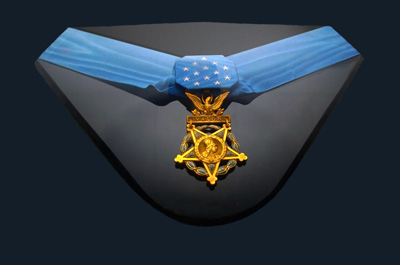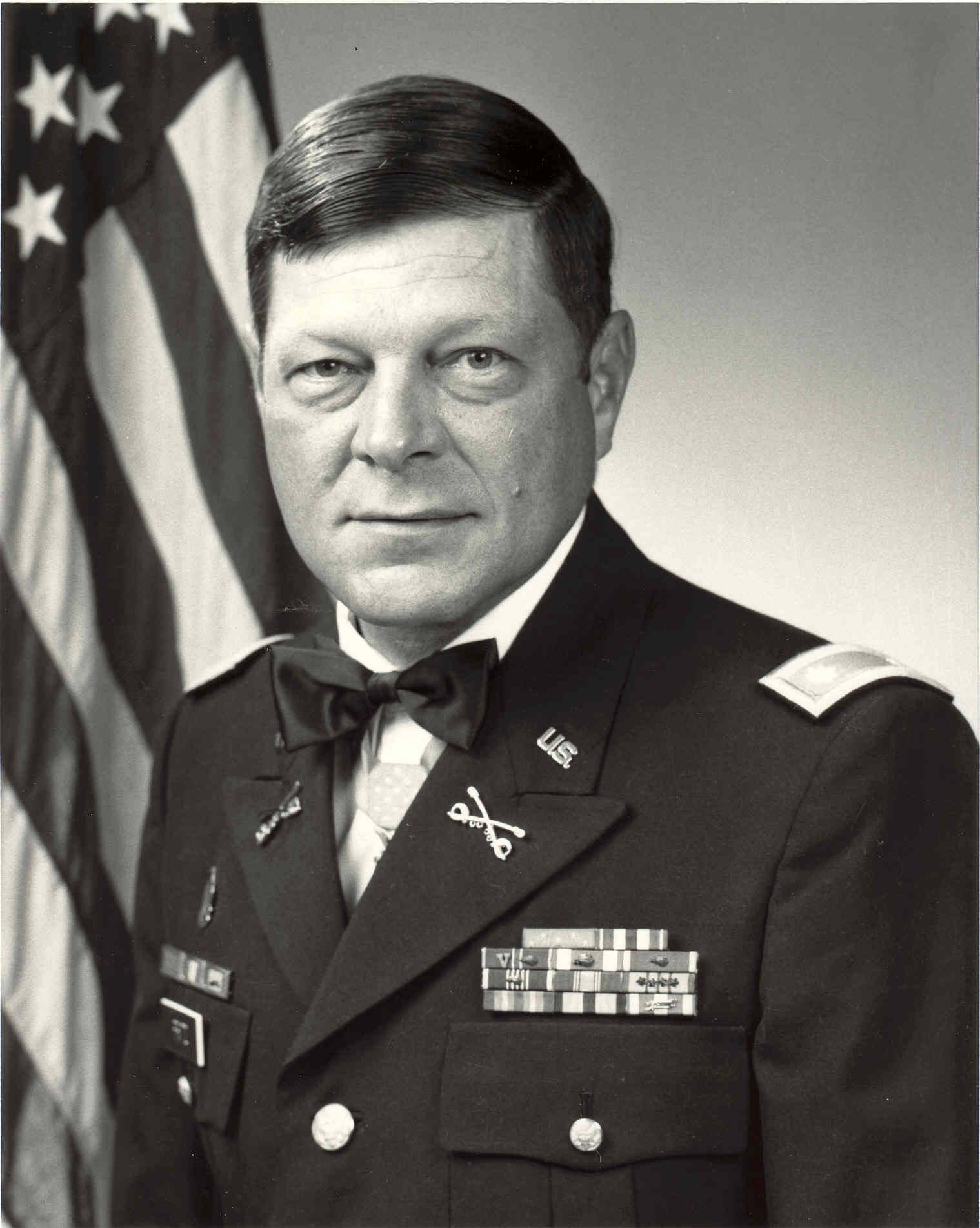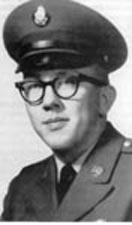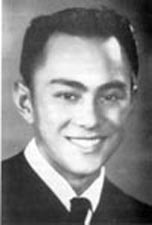ABOVE AND BEYOND
THE MEDAL OF HONOR

The Medal of Honor is the highest award for valor in action
against an enemy force which can be bestowed upon an individual serving in the Armed
Services of the United States. Generally presented to its recipient by the President of
the United States of America in the name of Congress, it is often called the Congressional
Medal of Honor.
The Medal of Honor is the highest
military award for bravery that can be given to any individual in the United States of America. Established by
joint resolution of Congress, 12 July 1862 (amended by Act of
9 July 1918 and Act of 25 July 1963.)
The first Medals of Honor awarded went
to six Union Army volunteers, members of Andrews’ (or Mitchel’s) Raiders. These men
attempted to disrupt the
Confederate rail lines between Atlanta and
Chattanooga. Disguised as civilians, the 19 soldiers, along with civilians James Andrews
and William Campbell, captured the locomotive General at Big Shanty, Georgia. Chased by
the persistent conductor of the General the raiders charged north, attempting to burn
bridges and destroy track along the way. Less than 20 miles south of Chattanooga the
"Great Locomotive Chase" ended. All of the raiders were captured and eight were
tried and executed.
On March 25, 1863, six of the raiders
arrived in Washington after parole from a
Confederate prison, and these six were the
first to be presented Medals of Honor by Secretary of War Stanton. Medals were later
awarded to 13 other raider members, some posthumously. The posthumous recipients of the
Medal from the "Great Locomotive Chase" are buried next to Ohio’s monument
to its participants, a replica of the General, at the Chattanooga National Cemetery.
Since those first six Medals of Honor
were awarded during the Civil War, only
3,408 individuals have received this most
valued recognition, 18 of them twice. By World War II the stature of this Medal was so
high that President Harry S. Truman, a World War I veteran who understood the horrors of
battle, once told a gathering of WWII recipients, "I’d rather have this Medal
than be President." General George S. Patton, another outstanding combat veteran who
clearly understood the bravery required in combat, told one recipient as he placed the
coveted Medal around the hero’s neck, "I’d give my immortal soul for that
Medal."
The Medal of Honor may only be awarded
for a deed of personal bravery or
self-sacrifice above and beyond the call
of duty only while the person is a member of the Armed Forces of the United States in
action against an enemy of the United States, or while engaged in military operations
involving conflict with an opposing foreign force, or while serving with friendly foreign
forces engaged in armed conflict against an opposing armed force in which the United
States is not a belligerent party.
In their provisions for judging whether
a person is entitled to the Medal of Honor, each of the armed services has set up
regulations which permit no margin of doubt or error. The deed of the person must be
proved by incontestable evidence of at least two eyewitnesses; it must be so outstanding
that it clearly distinguishes his gallantry beyond the call of duty from lesser forms of
bravery; it must involve the risk of his life; and it must be the type of deed which, if
he had not done it, would not subject him to any justified criticism.
* Award received
posthumously
RECIPIENTS
FRITZ, HAROLD A.

Rank and organization: Captain, U.S.
Army. Troop A, 1st Squadron, 11th Armored Cavalry Regiment
Place and date: Binh Long Province,
Republic of Vietnam, 11 January 1969
Entered service at:
Milwaukee, Wisconsin
Born: 21 February 1944, Chicago, Illinois
 Citation:
For conspicuous gallantry and intrepidity
in action at the risk of his life above and beyond the call of duty. Capt. (then 1st Lt.)
Fritz, Armor, U.S. Army, distinguished himself while serving as a platoon leader with
Troop A, near Quan Loi. Capt. Fritz was leading his 7-vehicle armored column along Highway
13 to meet and escort a truck convoy when the column suddenly came under intense crossfire
from a reinforced enemy company deployed in ambush positions. In the initial attack, Capt.
Fritz' vehicle was hit and he was seriously wounded. Realizing that his platoon was
completely surrounded, vastly outnumbered, and in danger of being overrun, Capt. Fritz
leaped to the top of his burning vehicle and directed the positioning of his remaining
vehicles and men. With complete disregard for his wounds and safety, he ran from vehicle
to vehicle in complete view of the enemy gunners in order to reposition his men, to
improve the defenses, to assist the wounded, to distribute ammunition, to direct fire, and
to provide encouragement to his men. When a strong enemy force assaulted the position and
attempted to overrun the platoon, Capt. Fritz manned a machine gun and through his
exemplary action inspired his men to deliver intense and deadly fire which broke the
assault and routed the attackers. Moments later a second enemy force advanced to within 2
meters of the position and threatened to overwhelm the defenders. Capt. Fritz, armed only
with a pistol and bayonet, led a small group of his men in a fierce and daring
charge which routed the attackers and inflicted heavy casualties. When a relief force
arrived, Capt. Fritz saw that it was not deploying effectively against the enemy
positions, and he moved through the heavy enemy fire to direct its deployment against the
hostile positions. This deployment forced the enemy to abandon the ambush site and
withdraw. Despite his wounds, Capt. Fritz returned to his position, assisted his men, and
refused medical attention until all of his wounded comrades had been treated and
evacuated. The extraordinary courage and selflessness displayed by Capt. Fritz, at the
repeated risk of his own life above and beyond the call of duty, were in keeping with the
highest traditions of the U.S. Army and reflect the greatest credit upon himself, his
unit, and the Armed Forces.
Citation:
For conspicuous gallantry and intrepidity
in action at the risk of his life above and beyond the call of duty. Capt. (then 1st Lt.)
Fritz, Armor, U.S. Army, distinguished himself while serving as a platoon leader with
Troop A, near Quan Loi. Capt. Fritz was leading his 7-vehicle armored column along Highway
13 to meet and escort a truck convoy when the column suddenly came under intense crossfire
from a reinforced enemy company deployed in ambush positions. In the initial attack, Capt.
Fritz' vehicle was hit and he was seriously wounded. Realizing that his platoon was
completely surrounded, vastly outnumbered, and in danger of being overrun, Capt. Fritz
leaped to the top of his burning vehicle and directed the positioning of his remaining
vehicles and men. With complete disregard for his wounds and safety, he ran from vehicle
to vehicle in complete view of the enemy gunners in order to reposition his men, to
improve the defenses, to assist the wounded, to distribute ammunition, to direct fire, and
to provide encouragement to his men. When a strong enemy force assaulted the position and
attempted to overrun the platoon, Capt. Fritz manned a machine gun and through his
exemplary action inspired his men to deliver intense and deadly fire which broke the
assault and routed the attackers. Moments later a second enemy force advanced to within 2
meters of the position and threatened to overwhelm the defenders. Capt. Fritz, armed only
with a pistol and bayonet, led a small group of his men in a fierce and daring
charge which routed the attackers and inflicted heavy casualties. When a relief force
arrived, Capt. Fritz saw that it was not deploying effectively against the enemy
positions, and he moved through the heavy enemy fire to direct its deployment against the
hostile positions. This deployment forced the enemy to abandon the ambush site and
withdraw. Despite his wounds, Capt. Fritz returned to his position, assisted his men, and
refused medical attention until all of his wounded comrades had been treated and
evacuated. The extraordinary courage and selflessness displayed by Capt. Fritz, at the
repeated risk of his own life above and beyond the call of duty, were in keeping with the
highest traditions of the U.S. Army and reflect the greatest credit upon himself, his
unit, and the Armed Forces.
WICKAM, JERRY WAYNE*

Rank and organization: Corporal, U.S.
Army, Troop F, 2d Squadron, 11th Armored Cavalry Regiment.
Place and date: Near Loc Ninh, Republic
of Vietnam, 6 January 1968.
Entered service at:
Chicago, Ill.
Born: 19 January 1942, Rockford, Ill.
 Citation:
Citation:
For conspicuous gallantry and
intrepidity in action at the risk of his life above and beyond the call of duty. Cpl.
Wickam, distinguished himself while serving with Troop F. Troop F was conducting a
reconnaissance in force mission southwest of Loc Ninh when the lead element of the
friendly force was subjected to a heavy barrage of rocket, automatic weapons, and small
arms fire from a well concealed enemy bunker complex. Disregarding the intense fire, Cpl.
Wickam leaped from his armored vehicle and assaulted one of the enemy bunkers and threw a
grenade into it, killing 2 enemy soldiers. He moved into the bunker, and with the aid of
another soldier, began to remove the body of one Viet Cong when he detected the sound of
an enemy grenade being charged. Cpl. Wickam warned his comrade and physically pushed him
away from the grenade thus protecting him from the force of the blast. When a second Viet
Cong bunker was discovered, he ran through a hail of enemy fire to deliver deadly fire
into the bunker, killing one enemy soldier. He also captured 1 Viet Cong who later
provided valuable information on enemy activity in the Loc Ninh area. After the patrol
withdrew and an air strike was conducted, Cpl. Wickam led his men back to evaluate the
success of the strike. They were immediately attacked again by enemy fire. Without
hesitation, he charged the bunker from which the fire was being directed, enabling the
remainder of his men to seek cover. He threw a grenade inside of the enemy's position
killing 2 Viet Cong and destroying the bunker. Moments later he was mortally wounded by
enemy fire. Cpl. Wickam's extraordinary heroism at the cost of his life were in keeping
with the highest traditions of the military service and reflect great credit upon himself
and the U.S. Army.
YANO, RODNEY J. T.*

Rank and organization: Sergeant First
Class, U.S. Army, Air Cavalry Troop, 11th Armored Cavalry Regiment.
Place and date: Near Bien Hao, Republic
of Vietnam, 1 January 1969.
Entered service at:
Honolulu, Hawaii.
Born: 13 December 1943, Kealakekua Kona,
Hawaii.  Citation:
Citation:
SFC. Yano distinguished himself while
serving with the Air Cavalry Troop. SFC. Yano was performing the duties of crew chief
aboard the troop's command-and-control helicopter during action against enemy forces
entrenched in dense jungle. From an exposed position in the face of intense small arms and
antiaircraft fire he delivered suppressive fire upon the enemy forces and marked their
positions with smoke and white phosphorous grenades, thus enabling his troop commander to
direct accurate and effective artillery fire against the hostile emplacements. A grenade,
exploding prematurely, covered him with burning phosphorous, and left him severely
wounded. Flaming fragments within the helicopter caused supplies and ammunition to
detonate. Dense white smoke filled the aircraft, obscuring the pilot's vision and causing
him to lose control. Although having the use of only 1 arm and being partially blinded by
the initial explosion, SFC. Yano completely disregarded his welfare and began hurling
blazing ammunition from the helicopter. In so doing he inflicted additional wounds upon
himself, yet he persisted until the danger was past. SFC. Yano's indomitable courage and
profound concern for his comrades averted loss of life and additional injury to the rest
of the crew. By his conspicuous gallantry at the cost of his life, in the highest
traditions of the military service, SFC. Yano has reflected great credit on himself, his
unit, and the U.S. Army.



